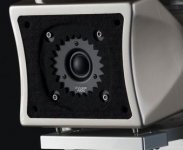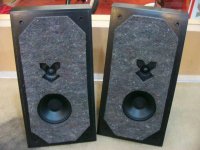Avoiding regular shapes helps to prevent resonances/reflections from different points at the same distance. But what Wilson does is mostly cosmetic. On BBC's LS3/5a studio monitor they just made the felt rectangular, so no fancy cutout, just performance.
Confirmed
Thats what I thought. I think a circle would be the worst as it is equi distant to the center of a dome tweeter. Makes it easy for me to use a square
Thats what I thought. I think a circle would be the worst as it is equi distant to the center of a dome tweeter. Makes it easy for me to use a square
For aesthetic considerations, sometimes we want something symmetrical. But the symmetry that pleases our eyes can work against us in acoustic performance.
Perhaps that is why Wilso uses a star-shaped cutout... perhaps it is the best comprimise between good performance and being non-ugly.
A square cutout is good, but a slightly star shaped is even better. A shape like this simulates better than a square cutout, but is still symmetrical.
And please don't ask me to quote a source... I read it once, and I don't remember where.
Perhaps that is why Wilso uses a star-shaped cutout... perhaps it is the best comprimise between good performance and being non-ugly.
A square cutout is good, but a slightly star shaped is even better. A shape like this simulates better than a square cutout, but is still symmetrical.
And please don't ask me to quote a source... I read it once, and I don't remember where.
Attachments
If the tweeter does its job and correctly projects the sound over the baffle, what's to say that the felt isn't creating diffraction instead? If so, is it intentional?
If the sound is properly in half space, the baffle is the only thing preventing diffraction. The felt is modifying the baffle.
I have a question regarding acoustic damping on baffle surrounding tweeters. Do you believe that the shape of the cut out matters or is it just for looks. See the Wilson audio picture. It has a complex cutout.
Damping material has a different acoustic impedance to air. At a step change in impedance a proportion of an incoming sound wave will enter the damping material to be steadily absorbed as it travels further through the material and a proportion will be reflected. The larger the change in impedance the stronger the (undesirable) reflection. The strength of the reflection can be reduced (at the cost of a bit less absorption) by ramping up the change in impedance by using wedge shapes. The wedges of foam on the walls of an anechoic chamber are a well known example.
So yes there can be benefits to changing the impedance gradually with wedge shapes but the effectiveness, if any, will depend on the details of how the sound is propagating and how the designer wants to modify it. It won't necessarily be beneficial but in a competent design it is likely to be preferable.
Diffraction means a change in direction as well as in intensity. Diffraction is a central issue in many areas, but not here, in the case of sound waves, as I see it.
The damping - by felt or similar material - around a tweeter (/mid?) - can probably be beneficial in cases where baffles either have "sharp" edges or even have protruding elements (like in some old-fashioned cabinet designs).
Regarding roundovers for baffles: They would need to have significant radiuses in order to be effective at lower frequencies. Which may be difficult or impossible to achieve in practice.
On the other hand: Similar problems will occur when attempting to absorb relatively low frequencies (< 2000 Hz), I guess ...
But then diffraction seems to be a real problem ONLY IF the distances between sound emitter and baffle edges are long relative to frequency. So for lower frequencies traveling along "smallish" baffles diffraction won't do much harm. (Apart from messing with directivity --> sound waves wrapping around cabinet edges --> speaker radiating into full space.)
Regarding roundovers for baffles: They would need to have significant radiuses in order to be effective at lower frequencies. Which may be difficult or impossible to achieve in practice.
On the other hand: Similar problems will occur when attempting to absorb relatively low frequencies (< 2000 Hz), I guess ...
But then diffraction seems to be a real problem ONLY IF the distances between sound emitter and baffle edges are long relative to frequency. So for lower frequencies traveling along "smallish" baffles diffraction won't do much harm. (Apart from messing with directivity --> sound waves wrapping around cabinet edges --> speaker radiating into full space.)
Interesting question. I can tell you that in a couple of experiments, I found the sound more pleasant with felt around the tweeter than without, but never attempted anything fancy like this.
As the felt reduces the pressure support that the baffle was otherwise giving, wouldn't the new wavefront edge expand into it, and travel along the wavefront creating an oblique higher order mode leading from the baffle?Diffraction means a change in direction as well as in intensity. Diffraction is a central issue in many areas, but not here, in the case of sound waves, as I see it.
I think the shape, star, trefoil or other, is mainly to spread the boundary, absorption over a band of frequencies.
Sort of lossy diffraction? Like perhaps an elliptical cone or baffle does?
I never got the whole "SupraBaffle" concept that is floating about the web... why use a circle?
Unless you are mounting the drivers, eccentric too, then it might make more sense.
Blur the diffraction.
The sphere is used, but isnt good either (not perfect at least)
Now perhaps an eccentrically mounted driver on an ellipse, or laid down egg shape, would work better.
Can we make the baffle behave like that shape, without making the baffle that shape?
Say by using graded absorption, thinnest near to the membrane, thickest at the baffle edges?
It's something I would love to experiment with, and measure, if I had the equipment to do so!
Take the guy that I first recall having g made those trapezoidal fronts...Humblehomemade high guy? Troels?
What if you exaggerated that, and then built the form back to rectangular, for ease of in foam sound absorbent.
Then cut away parts, to 'adjust"?
Sort of lossy diffraction? Like perhaps an elliptical cone or baffle does?
I never got the whole "SupraBaffle" concept that is floating about the web... why use a circle?
Unless you are mounting the drivers, eccentric too, then it might make more sense.
Blur the diffraction.
The sphere is used, but isnt good either (not perfect at least)
Now perhaps an eccentrically mounted driver on an ellipse, or laid down egg shape, would work better.
Can we make the baffle behave like that shape, without making the baffle that shape?
Say by using graded absorption, thinnest near to the membrane, thickest at the baffle edges?
It's something I would love to experiment with, and measure, if I had the equipment to do so!
Take the guy that I first recall having g made those trapezoidal fronts...Humblehomemade high guy? Troels?
What if you exaggerated that, and then built the form back to rectangular, for ease of in foam sound absorbent.
Then cut away parts, to 'adjust"?
Last edited:
This is what it appears (IMHO) to be about. There is going to be diffraction, it's just a matter of where and how.Can we make the baffle behave like that shape, without making the baffle that shape?
(BTW, I think you're talking about Tony Gee)
Regarding the suprabaffle, what's wrong with a circle that has been reasonably rounded back, surely offsetting the driver is based on compromise as well?
Well...of you read and understood the premise of my post that you quoted and appear to be agreeing with, then you know already.
If we are trying to blur the diffraction boundary so that it occurs over a wider range of frequencies, instead of a single or very narrow band of frequencies - then a circle, which has symmetry in all dimensions, on the plane of the baffle, is the worst shape.
If we are trying to blur the diffraction boundary so that it occurs over a wider range of frequencies, instead of a single or very narrow band of frequencies - then a circle, which has symmetry in all dimensions, on the plane of the baffle, is the worst shape.
Yes, it is the premise of the offset argument that diffraction should be spread in time, but typically the sharp edges are left in place.
I'm coming from a different point of view. My idea of changing the shape is to change the depth (think roundover) not the outline of the face. Depending on the radius, a roundover will work very well above a certain frequency. There should be no more need to worry about the baffle shape in that regard.
Then comes the argument that it is not an efficient use of space to use a large baffle and put a driver near the edge of it. Also, that this can produce an inconsistent off-axis behaviour.
I'm coming from a different point of view. My idea of changing the shape is to change the depth (think roundover) not the outline of the face. Depending on the radius, a roundover will work very well above a certain frequency. There should be no more need to worry about the baffle shape in that regard.
Then comes the argument that it is not an efficient use of space to use a large baffle and put a driver near the edge of it. Also, that this can produce an inconsistent off-axis behaviour.
I agree Allen, I have had very good results by using a generous roundover even though my tweeters are in simple rectangular baffles.
For people who do not have the capability of making a large radius roundover edge (or a deep bevel), thick felt can be a good way to go.
However I imagine it would be difficult to simulate... With this technique it becomes even more important to make your own driver measurements in your completed box, including all baffle felt damping...
For people who do not have the capability of making a large radius roundover edge (or a deep bevel), thick felt can be a good way to go.
However I imagine it would be difficult to simulate... With this technique it becomes even more important to make your own driver measurements in your completed box, including all baffle felt damping...
Last edited:
- Home
- Loudspeakers
- Multi-Way
- Tweeter baffle damping


